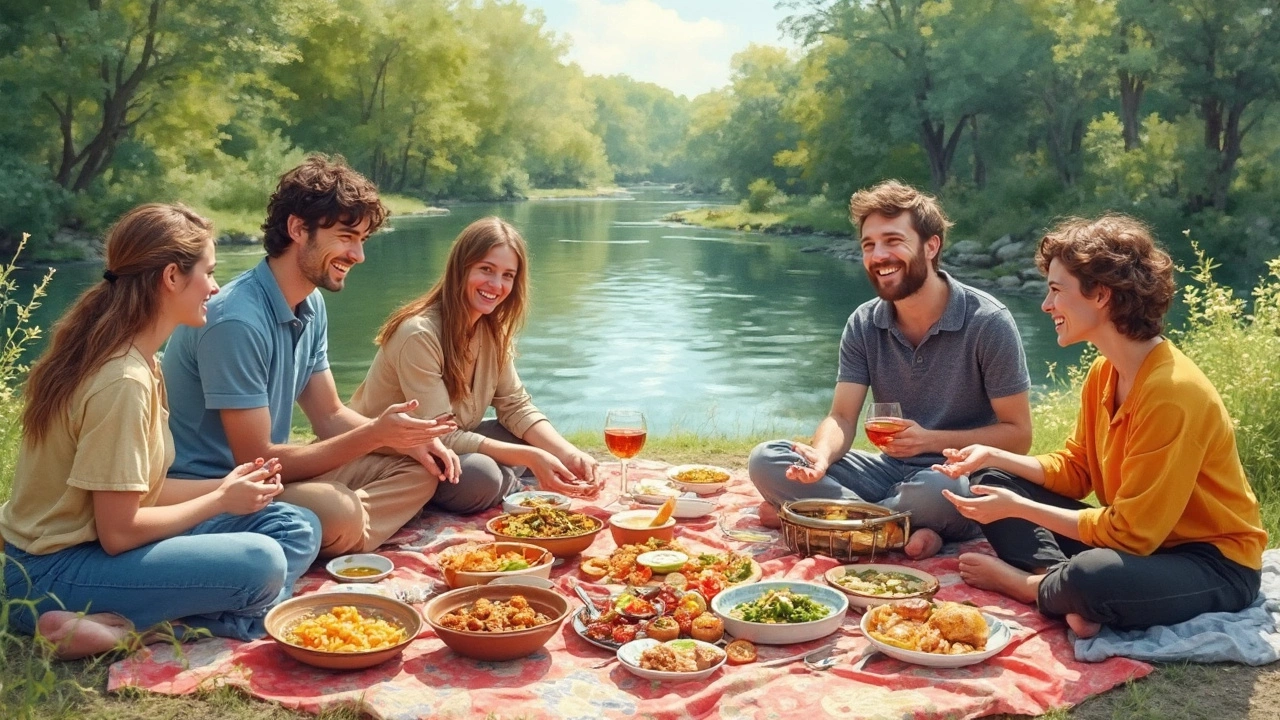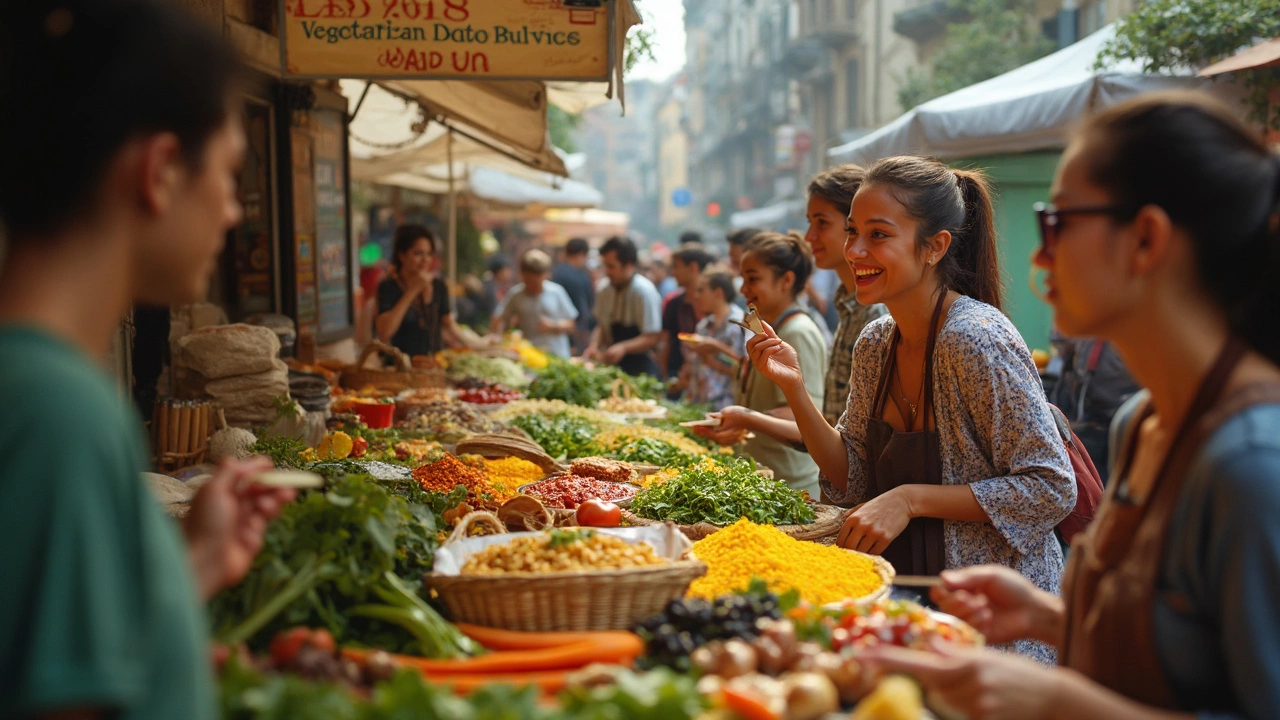If you say you’re vegetarian pretty much anywhere in the world, you’ll usually get stuck with either a salad, plain fries, or awkward stares. But in India, things flip upside down. Here, vegetarian food isn’t some afterthought—it's front and center, woven into daily life, religion, and even the menu at fancy weddings.
About 30-40% of India’s population sticks to a vegetarian diet, which means almost half a billion people are all-in when it comes to meatless eating. That’s more vegetarians living in one country than anywhere else, hands down. Major cities have dedicated veggie-only restaurants, and even international chains like Domino’s and McDonald’s offer entire vegetarian menus—marked clearly with a green dot on every box and wrapper.
This isn’t just about skipping meat. India’s recipes go way beyond salads, offering rich, filling dishes made with spices, grains, lentils, and fresh veggies. Whether you’re a lifelong plant-eater or just veg-curious, it’s easy to find something both tasty and satisfying in every region.
- Why India Tops Every Veggie List
- What Makes Indian Food Perfect for Vegetarians
- Eating Out and Shopping as a Vegetarian Traveler
- Vegetarian Recipes Inspired by Indian Classics
Why India Tops Every Veggie List
India isn’t just good for vegetarians—it’s the gold standard. If you’re searching for the ultimate vegetarian experience, this is as close as it gets. Walk down almost any street in India and you’ll see food stalls, bakeries, and restaurants with “Pure Veg” signs. For more than 300 million people, meatless eating is an everyday thing, not an exception.
Religion is a massive reason. Hinduism, Jainism, and Buddhism all encourage plant-based diets—and India has the world’s largest populations for each. So, vegetarian food isn’t just normal here; it’s part of culture, rituals, and family life. Jain families even have strict plant-based diets that skip root veggies like onions and garlic. Hindu communities avoid beef as a rule, and countless food festivals are full of colorful, meat-free options. Diwali and Holi, for example, feature spreads where not a single slice of meat is found.
Eating clean in India is easy because food laws back vegetarians up. All packaged food comes with clear color-coded dots—a green dot means 100% vegetarian, no hidden eggs or meat sneaking in. Walk into a McDonald’s and you’ll find McAloo Tikki, a potato burger specifically for the Indian market, made just for vegetarians. This is something you just don’t see anywhere else.
| Fact | Number |
|---|---|
| Estimated vegetarians in India | 400 million |
| Percent of Indian population vegetarian | 32% |
| “Veg only” restaurants in India | 30,000+ |
| Global rank for vegetarian-friendly countries | #1 |
If you’re traveling, you’ll see that being vegetarian here isn’t a hassle—it's just how people eat. Grocery stores, train stations, and hotel buffets all have real options, not just afterthoughts. Could you imagine finding this level of variety and comfort anywhere else?
- “Pure Veg” restaurants are common even in small towns
- Street food classics like samosas, pav bhaji, and aloo tikki are vegetarian as standard
- Special diets (vegan, gluten-free) aren’t rare in big cities
- Religious festivals guarantee meat-free feasts
The blend of history, faith, and daily life makes India truly a heaven for anyone who loves vegetarian food. You don’t have to search or compromise, it just comes with the territory.
What Makes Indian Food Perfect for Vegetarians
Indian food isn’t just vegetarian by default—it’s actually built for people who skip meat. It all starts with the basics: Hinduism, Jainism, and Buddhism have shaped the country’s food culture for centuries, making plant-based eating a normal part of life. Jain meals go an extra mile by skipping root veggies like onions, potatoes, and garlic, but you’ll find every region adds its twist on healthy, filling veggie dishes.
Here’s why you’ll never get bored eating vegetarian in India:
- Vegetarian doesn’t mean limited options. You get protein-packed dals, chickpea curries (think chana masala), and paneer dishes loaded with flavor.
- Spices do all the heavy lifting. Unique blends like garam masala, turmeric, cumin, and coriander bring life to simple ingredients. You don’t need meat for something to taste amazing.
- Street food is a goldmine. Grab a plate of samosas, aloo tikki, or pav bhaji and see how even grab-and-go snacks are filling, cheap, and meat-free.
- Diverse regions, diverse bites. From creamy North Indian palak paneer to South Indian masala dosa or coconutty avial from Kerala, there’s no monotony.
Even the supermarkets and mom-and-pop grocery stores make it easy. Lentils, beans, rices, and fresh produce are affordable and everywhere. Plus, restaurants mark vegetarian dishes clearly, so you never have to play guessing games with the menu.
If you want to avoid eggs or even garlic and onions, just ask for “Jain food” anywhere—everyone knows what that means. That’s rare to find outside India, where most people don’t know about these special options. And if you miss dairy, you’re in luck: paneer, ghee, and yogurt are the backbone of hundreds of classic Indian recipes, keeping things creamy and rich without using any meat at all.

Eating Out and Shopping as a Vegetarian Traveler
Eating out as a vegetarian in India can feel like you hit the jackpot. Street carts, fancy restaurants, and cafes have vegetarian options that are not just an afterthought—they’re the main event. Menus in most places use the "green dot" system to show which items are vegetarian. You never have to wonder if your food is safe from hidden meats because staff know these things matter and will usually double-check for you if you ask.
Quick fact: McDonald’s India has more than 70% of its menu vegetarian, offering everything from McAloo Tikki burgers to paneer wraps. Even Subway and Domino’s have whole veggie sections, which is way more than you’ll see anywhere else in the world. According to a travel report from the Indian tourism ministry, about 500,000 travelers a year come to India specifically because it’s easy for vegetarians to eat out.
| Chain | Veg-Only Locations (India) | Popular Vegetarian Items |
|---|---|---|
| McDonald’s | 95 | McAloo Tikki, Veg Maharaja Mac |
| Domino’s | 160 | Peppy Paneer Pizza, Veg Extravaganza |
| Subway | 120 | Aloo Patty Sub, Corn & Peas Sub |
Shopping for groceries? Local markets are packed with affordable, fresh veggies, tofu, paneer (think Indian cottage cheese), all types of lentils, and spices. Most supermarkets have a whole aisle or section dedicated to plant-based snacks and instant mixes—think dosa batters, idli mixes, and masalas. If you want to try cooking at your Airbnb or rented flat, just ask for whatever looks fresh at the market and someone will probably tell you how to cook it right there.
One tip: always check for the green dot symbol (it’s a green square with a green circle inside) on package labels. This means pure vegetarian—no eggs, no meat. If you’re worried about language barriers, the word “veg” (pronounced like ‘wedge’) is enough to get your point across. No one will judge you for being super clear—honestly, they’ll be happy to help you find what you need.
"India is the only country where vegetarians never feel like outsiders. Here, vegetarianism is not just respected; it is celebrated." — Lonely Planet
When eating out, here’s what to keep in mind so things stay easy and safe:
- Tell your server you want strictly vegetarian food, and repeat it if you have doubts.
- Look for "pure veg" restaurants. These spots don’t even keep eggs or meat in the kitchen.
- Try the thali—these are sampler plates with a bit of everything, always loaded with vegetarian curries, rice, breads, and pickles.
- If street food calls your name, stick to popular stalls with lots of locals (it usually means the food is both safe and fresh).
Bottom line: you won’t go hungry, or bored. Eating out and shopping in India as a vegetarian is so simple, you might even start to wonder why other countries make it so complicated.
Vegetarian Recipes Inspired by Indian Classics
If you want easy inspiration for your next meal, Indian cuisine has you covered. You don’t need fancy gear or hard-to-find ingredients—just some basic spices, everyday veggies, and a willingness to try new flavors. The cool part? Indian recipes are all about getting big taste from simple stuff like lentils, chickpeas, potatoes, and tomatoes.
Let’s look at everyday Indian dishes that go beyond curry. These are favorites that locals eat at home, not just restaurant specials. Plus, most of them are packed with protein, thanks to lentils and beans.
- Vegetarian Dal Tadka: This is comfort food in a bowl. Yellow or red lentils are simmered with onions, tomatoes, garlic, and finished with a sizzling tempering of cumin, chili, and garlic in oil. It’s cheap, quick, and super filling.
- Chana Masala: Chickpeas get simmered in tomato gravy with ginger, garlic, and lots of spices. It’s a street food favorite and makes a mean lunch when you pile it onto rice or eat with bread.
- Bhindi Masala: If you think you hate okra, this dish could change your mind. Sliced okra gets cooked with onions, tomatoes, and spices until everything is crisp and bursting with flavor—no slime in sight.
- Palak Paneer: Spinach and Indian cottage cheese team up in this creamy, vibrant dish. It packs in calcium, protein, and iron, which is great if you want more greens in your life.
If you’re trying these at home, don’t get hung up on getting every detail right. The flavor punch comes from spices like cumin, coriander, turmeric, and garam masala, which you can grab from most grocery stores. And nearly every dish works in a slow cooker or Instant Pot, making life even easier.
Want to see just how much protein and fiber are packed into these dishes? Check this out:
| Dish | Main Ingredient | Protein (g/serving) | Fiber (g/serving) |
|---|---|---|---|
| Dal Tadka | Lentils | 10 | 8 |
| Chana Masala | Chickpeas | 12 | 10 |
| Bhindi Masala | Okra | 3 | 4 |
| Palak Paneer | Spinach & Paneer | 14 | 3 |
Not a fan of spicy food? The heat level is totally up to you—add chili for extra kick or leave it out for a milder meal. And leftovers? Indian recipes taste even better the next day because the flavors keep building. So, next time you’re hungry and want something new, try out a real Indian classic at home. Your plant-based routine will thank you.

